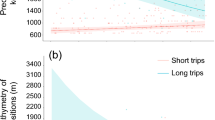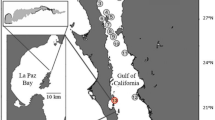Abstract
Long-distance passerine migrants deposit substantial fat stores to fuel their migratory journey. Many of those migratory birds arrive at their northerly breeding grounds with larger fat stores than were necessary to reach their breeding area. Both male and female American Redstarts (Setophaga ruticilla) arrived to breed in Michigan's Upper Peninsula with fat, and females arrived with more fat than males in 2 out of 3 years. We test the hypothesis that migrants arriving at the breeding grounds with more body fat have higher reproductive success than birds arriving with little or no fat. Females, and to a lesser extent males, that arrive with fat experience gains in reproductive performance as evidenced by increased clutch size, egg volume, and nestling mass. The results have implications for understanding how events occurring during one phase of the annual cycle influence survival and/or reproductive performance in subsequent phases.




Similar content being viewed by others
References
Akesson S, Karlsson L, Walinder G, Alerstam T (1996) Bimodal orientation and the occurrence of temporary reverse bird migration during autumn in south Scandinavia. Behav Ecol Sociobiol 38:293–302
Alerstam T (1978) Reoriented bird migration in coastal areas: dispersal to suitable resting grounds? Oikos 30:405–408
Ankney CD, MacInnes CD (1978) Nutrient reserves and reproductive performance of female Lesser Snow Geese. Auk 95:459–471
Arcese P, Smith JNM (1988) Effects of population density and supplemental food on reproduction in Song Sparrows. J Anim Ecol 57:119–136
Bairlein F (1985) Body weights and fat deposition of Palearctic passerine migrants in the central Sahara. Oecologia 66:141–146
Biebach H, Friedrich W, Heine G (1986) Interaction of bodymass, fat, foraging and stopover period in trans-Sahara migrating passerine birds. Oecologia 69:370–379
Blem CR (1980) The energetics of migration. In: Gauthreaux SAJ (ed) Animal migration, orientation, and navigation. Academic Press, New York, pp 175–224
Blem CR (1990) Avian energy storage. In: DM Power (ed) Current ornithology, vol 7. Plenum Press, New York, pp 59–113
Brown CR, Brown MB (2000) Weather-mediated natural selection on arrival time in cliff swallows Petrohelidon pyrrhonota. Behav Ecol Sociobiol 47:339–345
Carey C (1996) Female reproductive energetics. In: Carey C (ed) Avian energetics and nutritional ecology. Chapman and Hall, New York, pp 324–374
Daan S, Dijkstra C, Drent R, Meijer T (1988) Food supply and the annual timing of avian reproduction. In: Ouellet H (ed) Acta 19th Congressus Internationalis Ornithologici. University of Ottawa Press, Ottawa, pp 342–352
Davies NB, Lundberg A (1985) The influence of food on time budgets and timing of breeding in the Dunnock Prunella modularis. Ibis 127:100–110
Dence WA (1946) Tree Swallow mortality from exposure during unseasonable weather. Auk 63:440
Drent RH, Daan S (1980) The prudent parent: energetic adjustments in avian breeding. Ardea 68:225–252
Ewert DN, Hamas MJ (1995) Ecology of migratory landbirds during migration in the midwest. In: Thompson FR (ed) Management of midwestern landscapes for the conservation of neotropical migratory birds. General Technical Report NC-187. North Central Forest Experiment Station, Forest Service, U.S. Department of Agriculture, Detroit, Mich., pp 200–208
Francis CM, Cooke F (1986) Differential timing of spring migration in wood warblers (Parulinae). Auk 103:548–556
Fransson T, Jakobsson S (1998) Fat storage in male Willow Warblers in spring: do residents arrive lean or fat? Auk 115:759–763
Gosler AG, Harper DGC (2000) Assessing the heritability of body condition in birds: a challenge exemplified by the Great Tit Parus major L. (Aves). Biol J Linn Soc 71:103–117
Helms CW (1968) Food, fat and feathers. Am Zool 8:151–167
Helms CW, Drury WHJ (1960) Winter and migratory weight and fat field studies on some North American buntings. Bird-banding 31:1–40
Ketterson E, Nolan VJ (1983) The evolution of differential bird migration. In: Johnston RF (ed) Current ornithology, vol 3. Plenum Press, New York, pp 357–402
King JR (1972) Adaptive periodic storage by birds. In: Voous KH (ed) Acta 15th Congressus Internationalis Ornithologici, Leiden, pp 200–217
King JR, Barker S, Farner DS (1963) A comparison of energy reserves during autumnal and vernal periods in the White-crowned Sparrow, Zonotrichia leucophrys gambelli. Ecology 44:513–521
Klaassen M, Lindström Å, Meltofte H, Piersma T (2001) Arctic waders are not capital breeders. Nature 413:794
Krementz DG, Pendleton GW (1990) Fat scoring: sources of variability. Condor 92:500–507
Magrath RD (1991) Nestling weight and juvenile survival in the Blackbird, Turdus merula. J Anim Ecol 60:335–351
Magrath RD (1992) The effect of egg mass on the growth and survival of blackbirds: a field experiment. J Zool 227:639–653
Marra PP, Hobson KA, Holmes RT (1998) Linking winter and summer events in a migratory bird by using stable-carbon isotopes. Science 282:1884–1886
Martin TE (1987) Food as a limit on breeding birds: a life history perspective. Annu Rev Ecol Syst 18:453–487
Martin TE, Karr JR (1990). Behavioral plasticity of foraging maneuvers of migratory warblers: multiple selection periods for niches? Stud Avian Biol 13:353–359
McLandress MR, Raveling DG (1981) Changes in diet and body composition of Canada Geese before spring migration. Auk 98:65–79
Meijer T, Drent R (1999) Re-examination of the capital and income dichotomy in breeding birds. Ibis 141:399–414
Møller AP (1994) Sexual selection and the Barn Swallow. Oxford University Press, New York
Moore FR, Kerlinger P (1987) Stopover and fat deposition by North American wood-warblers (Parulinae) following spring migration over the Gulf of Mexico. Oecologia 74:47–54
Moore FR, Gauthreaux SAJ, Kerlinger P, Simons TR (1995) Habitat requirements during migration: important link in conservation. In: Martin TE, Finch DM (eds) Ecology and management of neotropical migratory birds. Oxford University Press, New York, pp 121–144
Nagy KA (1987) Field metabolic rate and food requirement scaling in mammals and birds. Ecol Monogr 57:111–123
Nilsson J-Å (1994) Energetic bottle-necks during breeding and the reproductive cost of being too early. J Anim Ecol 63:200–208
Noordwijk AJ van, McCleery RH, Perrins CM (1995) Selection for the timing of great tit breeding in relation to caterpillar growth and temperature. J Anim Ecol 64:451–458
Odum EP (1993) Body masses and composition of migrant birds in the Eastern United States. In: Dunning JB Jr (ed) CRC handbook of avian body masses. CRC Press, New York, pp 313–334
Ojanen M (1984) The relation between spring migration and the onset of breeding in the Pied Flycatcher Ficedula hypoleuca in northern Finland. Ann Zool Fenn 21:205–208
Perrins CM (1970) The timing of birds' breeding seasons. Ibis 112:242–255
Price TD, Kirkpatrick M, Arnold SJ (1988). Directional selection and the evolution of breeding date in birds. Science 240:798–799
Pyle P (1997) Identification guide to North American birds. Slate Creek Press, Bolinas, Calif.
Raveling DG (1979) The annual cycle of body composition of Canada Geese with special reference to control of reproduction. Auk 96:234–252
Reid ML (1987) Costliness and reliability in the singing vigor of Ipswich Sparrows. Anim Behav 35:1735–1743
Romero ML, Soma KK, O'Reilly KM, Suydam R, Wingfield JC (1997) Territorial behavior, hormonal changes, and body condition in an Arctic-breeding song bird, the Redpoll (Carduelis flammea). Behaviour 134:727–747
Rowe LD, Ludwig D, Schluter D (1994) Time, condition, and the seasonal decline of avian clutch size. Am Nat 143:698–722
Sandberg R (1996) Fat reserves of migrating passerines at arrival on the breeding grounds in Swedish Lapland. Ibis 138:514–524
Sandberg R, Moore FR (1996) Fat stores and arrival on the breeding grounds: reproductive consequences for passerine migrants. Oikos 77:577–581
Sherry TW, Holmes RT (1997) American Redstart Setophaga ruticilla. In: Poole A, Gill F (eds) The birds of North America, no. 277. The Academy of Natural Sciences, Philadelphia, Pa., and The American Ornithologists' Union, Washington, D.C.
Siegel S, Castellan NJ Jr (1988) Nonparametric statistics for the behavioral sciences. McGraw Hill, Boston
Slagsvold T (1976) Arrival of birds from spring migration in relation to vegetational development. Norw J Zool 24:161–173
Smith HG, Bruun M (1998) The effect of egg size and habitat on starling nestling growth and survival. Oecologia 115:59–63
SPSS (1999) SPSS for Windows, Release 9.0. SPSS, Chicago, Ill.
SYSTAT (1997) SYSTAT for Windows, Release 7.0. SYSTAT, Richmond, Calif.
Terrill SB, Ohmart RD (1984) Facultative extension of fall migration by Yellow-rumped Warblers Dendroica coronata. Auk 101:427–438
Walsberg GE (1983) Avian ecological energetics. In: Farner DS, King JR Parkes KC (eds) Avian biology, vol 7. Academic Press, New York, pp 161–220
Wasserman FE, Cigliano JA (1991) Song output and stimulation of the female in White-throated Sparrows. Behav Ecol Sociobiol 29:424–426
Williams JB, Siegfreid WR, Milton SJ, Adams NJ, Dean WRJ, Du Plessis MA, Jackson S (1993) Field metabolism, water requirements, and foraging behavior of wild ostriches in the Namib. Ecology 74:390–404
Winkler DW, Allen PE (1996) The seasonal decline in Tree Swallow clutch size: physiological constraint or strategic adjustment? Ecology 77:922–932
Woodrey MS, Moore FR (1997) Age-related differences in the stopover of fall landbird migrants on the coast of Alabama. Auk 114:695–707
Zar JH (1996) Biostatistical analysis, 3rd edn. Prentice-Hall, New Jersey
Zumeta DC, Holmes RT (1978) Habitat shift and roadside mortality of Scarlet Tanagers during a cold wet New England spring. Wilson Bull 90:575–586
Acknowledgements
We thank Roland Sandberg, Jeff Buler, David Cimprich, Jeff Clark, Colleen Dwyer, Jeff Farrington, Sarah Mabey, Jeff Mollenhauer, Jen Owen, Chris Szell, Stefan Woltman, and Mark Woodrey. Mark Chappell and two anonymous reviewers significantly improved the manuscript. The research was supported by the National Science Foundation (DEB-0073190), the Animal Behavior Society, Eastern Bird Banding Association, Sigma Xi, the Frank M. Chapman Memorial Student Research Fund, the Kalamazoo Audubon Society, U.S. Fish and Wildlife Service, and Barbara and Gerald Meyers. We thank Hiawatha National Forest for permission to perform this research on Forest Service property, and we are grateful to The Nature Conservancy, MI Chapter (notably Dr. David Ewert) and Dr. Mic Hamas of Central Michigan University for logistical help. Finally, we thank our field crews for their dedicated efforts.
Author information
Authors and Affiliations
Corresponding author
Rights and permissions
About this article
Cite this article
Smith, R.J., Moore, F.R. Arrival fat and reproductive performance in a long-distance passerine migrant. Oecologia 134, 325–331 (2003). https://doi.org/10.1007/s00442-002-1152-9
Received:
Accepted:
Published:
Issue Date:
DOI: https://doi.org/10.1007/s00442-002-1152-9




